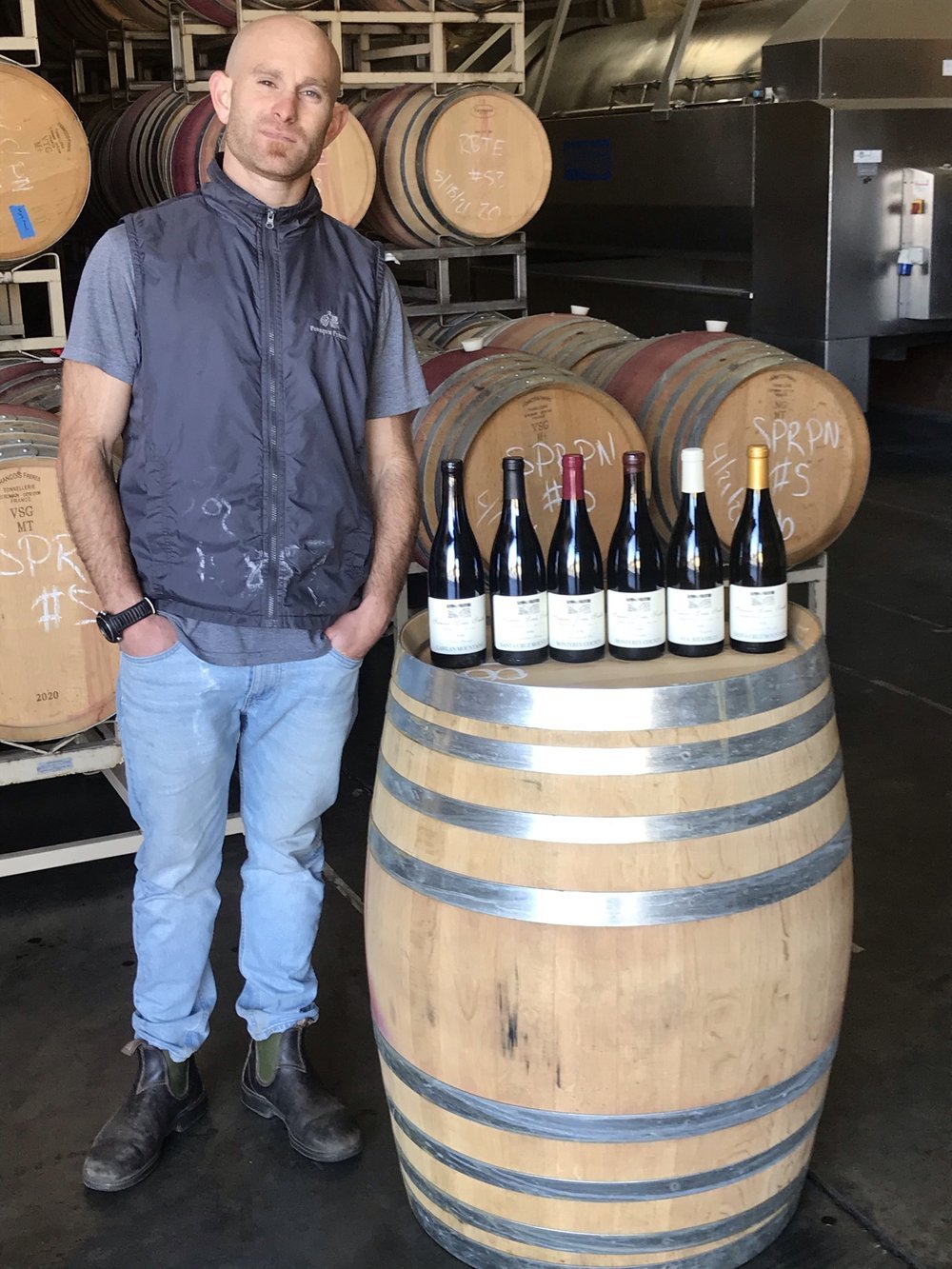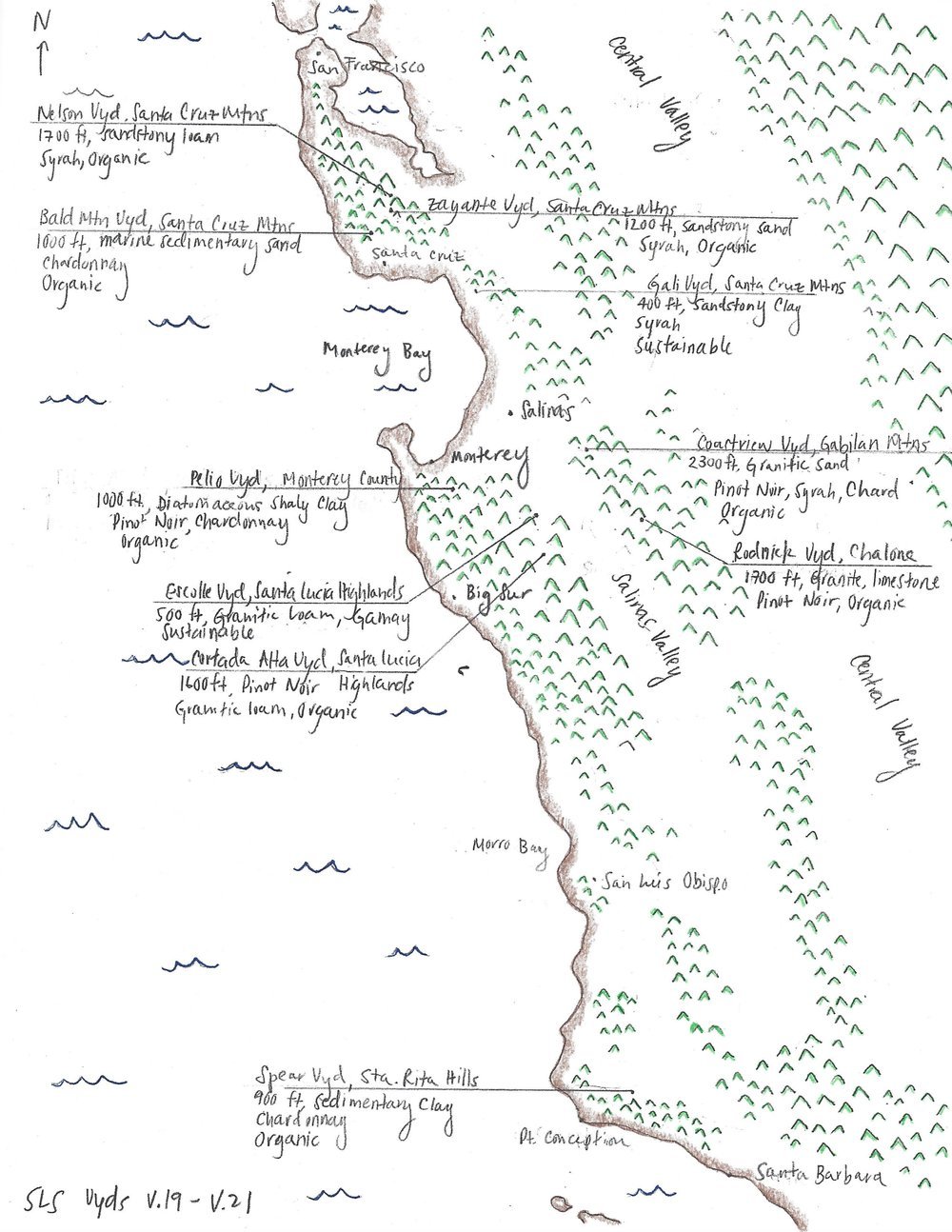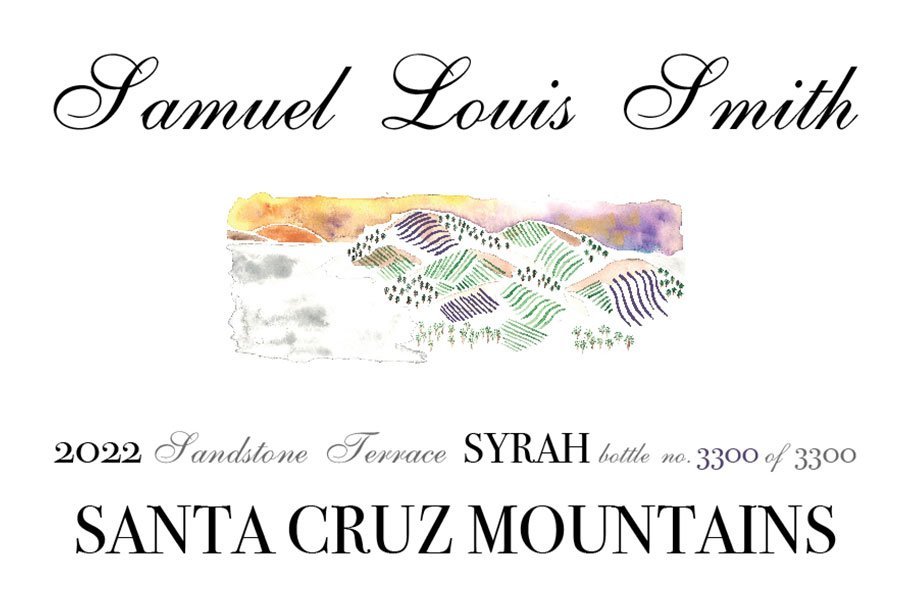
Samuel Louis Smith
Salinas, Monterey, California






We’ll cut to the chase. The 2022 vintage from Samuel Louis Smith is possibly his most complete and thrilling line-up to date. Sam refers to himself as a “neo-classicist” winemaker, meaning that he’s working to revive a style of classic California wines that has disappeared over the years. His wines, from peripheral and stunningly gorgeous vineyard sites located at high altitudes, are noteworthy for their balance, purity, complexity, and relatively low alcohol. Sam has a particular skill in coaxing minerality, spice notes, and supple fruit from his vineyards. His work in the cellar, through his use of whole cluster fermentation, vineyard specific pied de cuves and a judicious use of oak, is meant to offer the purest expression of cool California wines possible.
With a tiny 1000 case production, split among six to eight cuvées, it’s no surprise Sam’s eponymous micro-négociant project has flown under the radar. Working out of a shared garage space in Salinas and tending to a handful of singular, organically farmed plots up and down the 101 and Pacific Coast Highway, Sam isn’t afforded a ton of time to work the market, and until recently, he even worked full-time as the head winemaker for Morgan Winery, the organic producer in Santa Lucia Highlands. As exhausting as his schedule is, he somehow pulls it off, and we’re just here to tell you: drink these wines.
Sam’s nervy yet texture-driven Chardonnays, lifted, whole-cluster Syrah and Pinots, and juicy, Fleurie/Morgon-inspired Gamay have us believing in the new generation of California wine. Indeed, the whole SLS project flies in the face of the over-production of commodity wine grapes, the utter glut of custom-crush brands manifesting themselves out of thin air. There is endurance and realness in the “micro” and the unscalable at the heart of the SLS project.
Though a native Californian, Sam’s journey down the wine trail began in 2009 when he took his first trip to France as a university student, landing in Bordeaux and discovering the world of wine while studying French. Eventually pivoting career paths from poli sci to wine making, he went to work under Santa Barbara legend Doug Margerum of Margerum Wine Company, and by 2014, produced his first vintage under the eponymous Samuel Louis Smith label.
2015 was the next pivotal year for Sam, journeying back to France – this time to the Northern Rhône – to stage with François Villard. Like Sam, Villard was not born into a wine family, and he found his way by making small runs of Condrieu in the early 90s until becoming a true benchmark producer for the region in the coming decades.It was during that summer and fall of 2015 — the first of a string of warm, ripe vintages not dissimilar to those in Northern California — where Sam learned how to make fresh wines despite high temps. At Villard, it was crucial to focus on extraction temperature and ratios of whole cluster to destemmed fruit. His time in France was also spent studying the greats, from Morey-Saint-Denis to Hermitage, and finding a particular love of the wines of Dujac, Arnaud Ente, Julien Sunier, Gonon, and Jamet. This certainly influenced his own winemaking style upon returning to California.
In 2016, Sam began to work under Santa Lucia Highland’s pioneer of organic viticulture, Dan Lee of Morgan Winery. While also working at Morgan full-time, Sam put his experience in the Rhône to work, making his first Sandstone Terraces Syrah in 2016, along with one single vineyard pinot under the SLS label. The Sandstone Syrah has remained a staple in Sam’s lineup nearly every vintage since. And every vineyard Sam works with, save for the Gamay from Escolle, is farmed organically or in organic conversion.
All of Sam’s wines begin life with pied de cuve, or a wild-yeast culture cultivated in a small batch of must. Small batches of grapes are crushed and left to ferment in each individual vineyard, building up robust yeast cultures to kick-start fermentation of the remaining juice. Because he works in a shared facility, this technique prevents cross-contamination of yeasts from different vineyards and enhances the sense of site-specificity.
For reds, Sam works judiciously with whole cluster fruit and ripe stems. Sam believes the only way to determine if the stems are ripe and useful for winemaking is to chew them, right off the vine. The spice of the ripe stems is what finds its way into the finished wines. This year's Pelio Pinot Noir is 90% whole cluster, with the stunning balance of both lift and tannin. The Syrah similarly utilizes high proportions of whole bunches. He forgoes fining and filtering to preserve this texture in reds (whites are unfined but go through light filtration).
Zooming out of the cellar and looking at the big picture of California wine in 2024, we find youthful producers like Sam re-energizing us as wine lovers. By uncovering a handful of fringe sites, shrouded by the marine layer, he shows us what new expressions of Pinot Noir, Chardonnay, Syrah, and Gamay are possible with a deft hand and a light touch. Coastal and mountainous wines with energy, poise, and structure without the excessive warmth and high alcohol – this is the new face of the West Coast.
2022 Vintage — This year found Sam confronting one of the more challenging vintages to date: early bud break in March, a succession of heat wave, frost, rain during the growing season, lower cluster counts and widespread shatter due to multi-year drought. Average to above average temperatures, along with less marine layer through the summer, confirmed that this year would be an early harvest. A week-long heatwave starting Labor Day Weekend would hasten ripening and further diminished crop loads. Thankfully, weather for the remainder of harvest was back to normal, though the heatwave and tiny yields forced most parcels to ripen simultaneously — not easy when each bunch is hand-harvested. At first glance, 2022 seems to be a combination of 2014 and 2017 and the end result for the vintage was clean, fruit-driven, and fairly opulent wines with individuality determined by pick date (before, durning, or after the heatwave).
Our Selections
Samuel Louis Smith Chardonnay ‘Les Granitiers’ Gabilan Mountains 2022
Granitier is French for a granite quarry worker, therefore an apt term for this wine hailing primarily (86%) from the granitic Coastview Vineyard. Situated 2,300 ft up the Gabilan Mountains, it’s one of the most dramatically beautiful sites on the Central Coast. The remaining 14% comes from Pelio Vineyard. Inspired by great Burgundy appellations named after old quarries (Meursault Perrieres anyone?), this Chardonnay is a wonderful balancing act of orchard and citrus fruits with crushed rocks, and white flowers. Crisp texture with real length.
Native fermentation started with a pied de cuve from the vineyard. Alcoholic fermentation occurred in stainless steel and malolactic occurred in barrel. 10 months élévage in 29% second-fill, 57% neutral, and 14% stainless steel barrels. Pale gold. Orchard and citrus fruits, crushed rocks, and white flowers are followed by hints of pineapple, sea breeze, and toast. Light bodied with very lively acidity and smooth texture. WE:94
Three and a half barrels • 84 cases produced. 12.3% alcohol | 3.24 pH |
Samuel Louis Smith Chardonnay Spear Vineyard Sta. Rita Hills 2022
Spear is a young, yet very exciting site in the heart of the Sta. Rita Hills. Planted in 2014 and farmed organically by Ofer Shepher, its northern border and steep north-facing slopes hug Highway 246. Varied elevation reaches 900 feet and soils are comprised of marine sedimentary clay and sand.
Native alcoholic and malolactic fermentations occurred in barrel. 10 months élévage in 17% new, 17% second-fill, and 66% neutral barrels.. Pale yellow with lemon curd, toasted vanilla bean, sea spray, and lime zest are followed by hints of citrus pith and salted toffee. Medium bodied with bright acidity and elegant chalky texture. WE:95
6 barrels • 144 cases produced. 12.9% Alcohol | 3.25 pH
Samuel Louis Smith Gamay Escolle Vineyard Sta. Lucia Highlands 2022
For those not familiar with Santa Lucia Highlands, it’s an incredible, 18-mile-long northeast facing bench in the windswept Salinas Valley. The mountainside appellation divides the Santa Lucia mountain range to the west from the Salinas Valley floor to the east. Escolle Vineyard is blessed with an incredibly cool microclimate thanks to nearby Monterey Bay, and the pairing of gamay noir on granitic loam at Escolle is one part of the SLH renaissance.
Precisely medium-weight with lift and fine-grain tannin, this Gamay takes its inspiration from the wines of Julien Sunier. Rose petal, cracked pepper, savory herbs, and raspberry candy are followed by hints of cured meat, salted plum, and damp earth. 75% whole-cluster and 25% carbonic maceration. Native fermentation started by a pied de cuve from the vineyard after seven day carbonic. Seven months élévage in 100% neutral French oak barrels. Bottled unfined & unfiltered.
Five and a half barrels • 135 cases produced. 12.7% Alcohol | 3.51 pH
Samuel Louis Smith Syrah Sandstone Terrace Santa Cruz Mountains 2022
Sandstone Terrace is a blend of primarily Santa Cruz Mountains cool-climate Syrah sites with the common thread of sandstone-derived soils. In most vintages, it embodies the sexy, spicy, and floral side of the varietal.
Nelson Vineyard (44%) is located in the Summit district of the SCM. The property was planted to chardonnay, pinot noir, and syrah in ‘99, after spending 30 years as a Christmas tree farm best known for silvertip firs, a variety that thrives at higher elevations. At 1700 ft, the vines growing in sandy loam and chunky sandstone are surrounded by redwoods and firs. Organically farmed.
Gali Vineyard (42%) is located in the Corralitos district of the southern SCM. At the low elevation of 400 ft and approximately six miles from the ocean, this is one of the coldest sites in our lineup. Soils are clay loam weathered from sandstone and shale, formed on ancient submarine terraces. In conversion to organics.
Tondré Vineyard (14%) was planted in ‘97 in the heart of the Santa Lucia Highlands, in granitic loam and extremely cool climate thanks to nearby Monterey Bay’s contribution of persistent morning fog and windy, sunny afternoons.
80% whole cluster fermentation. Native primary and secondary fermentations. Ten months élévage in 38% second-fill and 62% neutral French oak barrels. Unfined & unfiltered.
Dark purple. Black plum, brambleberry, white pepper, and dried violets are followed by black fruits, cured and smoked meats, and savory spices on the palate. Medium bodied with elegant chalky tannins.
Eight barrels • 193 cases produced. 12.8% Alcohol | 3.68 pH | 6.9 TA
Samuel Louis Smith Syrah Coastview Vineyard Gabilan Mountains 2022
Coastview is situated on a ridgetop 2300 ft up the Gabilan Mountains, and one of the most dramatically beautiful sites on the Central Coast. This is truly a fringe site, where thin soils of decomposed granite with veins of limestone are primarily planted to a chardonnay, pinot noir, and syrah. Organically farmed, it produces wines with crunchy freshness and elegant structure.
100% whole cluster fermentation with native alcoholic and malolactic fermentations. The wine spends ten months aging in 50% second-fill and 50% neutral French oak barrels. Bottled unfined and unfiltered.
The dark purple color is suggestive of the ripe black fruits, white pepper, and smoked meat on the nose. We find hints of game, savory spices, and damp earth. Medium bodied with bright acidity and elegant tannins.
Two barrels • 47 cases produced. 12.9% Alcohol | 3.65 pH
Samuel Louis Smith Pinot Noir Montañita de Oro Monterey County 2022
Sam showcases mountainous Monterey Pinot sites in his Montañita de Oro cuvée. With an average elevation of 1100 ft, high-toned aromatics are framed by earthy fruit and elegant structure. The following vineyards were used:
Double L Vineyard (36%) was planted in ‘97 and to this day is the only certified organic vineyard in the Santa Lucia Highlands. Located at 450 ft in the cool, northern section of the appellation, the vines are planted in sandy and clay granitic loam, blasted by afternoon wind and sun.
Pelio Vineyard (34%) is located just west of Laureles Grade in Carmel Valley, in what will soon be the Carmel Coast AVA. At 1,000 ft and six miles from Monterey Bay, this site is truly on the edge of viticulture. Clay loam is littered with diatomaceous shale, evidence that this area was under the sea until about 12 million years ago. Organically farmed.
Rodnick Vineyard (30%) was first planted in ‘86, in the Chalone appellation of the Gabilan Mountains at 1600-1900 ft. Decomposed granite and limestone soils in this high desert climate create a compelling terroir for growing earthy, structure-driven wines. Organically farmed.
53% whole cluster with native fermentation started by a pied de cuve from the vineyard. 10 months élévage in 22% new, 11% second-fill, and 67% neutral French oak barrels.
Wild cherry, savory herbs, rose petal, and blood orange are followed by high-toned red fruit and earth tones. Deep red. Sweet and savory spices on the palate. Medium body framed by elegant tannins. An incredible snapshot of California Pinot Noir in 2022. WE:93
Nine barrels • 216 cases produced. 13.3% Alcohol | 3.78 pH
Samuel Louis Smith Pinot Noir Pelio Vineyard Monterey County 2022
Pelio is located just west of Laureles Grade in Carmel Valley, in what will soon be the Carmel Coast AVA. At 1,000 ft and six miles from Monterey Bay, this site is truly on the edge of viticulture. Clay loam is littered with diatomaceous shale, evidence that this area was under the sea until about 12 million years ago. Planted in 2003 and organically farmed.
69% whole cluster fermentation. Native primary and secondary fermentations. 10 months élévage in 34% new and 66% neutral French oak barrels. Unfined & unfiltered.
Deep red. Wild cherry, black plum, rose hips, and Christmas spice on the nose are followed by red and black fruits, cola, and sweet and savory spices on the palate. A medium body is framed by bright acidity and fine-grained tannins, adding depth and ageability.
Three barrels • 72 cases produced. 12.8% Alcohol | 3.56 pH | 6.7 TA







